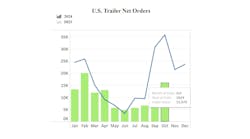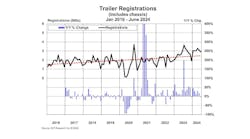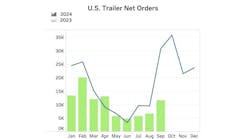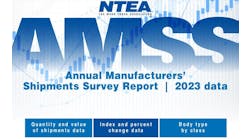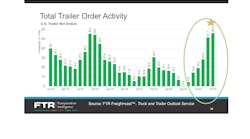'Abnormal' markets should calm in 2021, leading to 'near-record' 2022 for equipment: FTR
Early in the recent FTR Transportation Intelligence presentation of their 2021 outlook, Chairman and CEO Eric Starks conceded “there is no ‘normal’ anymore—we don't even know what the heck that is.”
And it doesn’t take a team of economic experts to explain that the pandemic has led to a substantial deviation from “normal” trends in 2020. However, making sense of these unprecedented times—and coming up with a trustworthy forecast for the transportation equipment markets—does require an adjustment to the models. So the team at FTR put their collective heads together in the Dec. 10 FTR Engage web session to lay out their early take on the coming year or two for subscribers and the trade media.
Crucial to the equipment markets is the pandemic’s impact on freight. As Starks pointed out, GDP goods transport was up 85% in the third quarter this year, more than making up for losses in the first and second quarter as the pandemic took hold. Interestingly, industrial production continues to lag significantly.
The “disconnect” comes with growth in consumer goods volumes, particularly in e-commerce and home delivery—putting pressure on local delivery services.
Indeed, local delivery accounted for one in three jobs added to the economy in November; and more than half of all new hires come from freight-related businesses when the trucking and warehousing sectors are included, suggested Avery Vise, FTR vice president of trucking.
The shift in consumer spending from services—dining out, going to movies and ball games, traveling for vacation—to spending on goods because of additional disposable income (for those still employed) or to assist in the transition to working from home, caught the supply chain by surprise, Bill Witte, FTR’s economy expert, noted.
“People with higher income … either can’t or won’t spend it on services, so they’re spending it on goods,” Witte said.
And that spending comes in a way that few expected or planned for, Don Ake, vice president of commercial vehicles, explained.
“The fleets were a little caught behind being able to handle [the surge in consumer goods spending],” Ake said. “So now you see the fleets having to catch up with equipment. They don't have enough. More importantly, this has also caused a disruption in the supply chain, especially in manufacturing.
“The system is in catch-up mode, and it's far from normal. And this is one of the things that is causing disruption in the supply chain, in the economy and the like—and everything involved with transportation.”
And that’s exactly the point, as Ake detailed in his analysis of equipment trends: The data is “abnormal.”
For instance, the 50,000 Class 8 trucks order total for November—the third highest ever—reflects the “potential demand” for the trucks, based on “conditions now.” And those conditions are driven by capacity constraints and OEM supply shortages.
“That's causing the fleets to order their equipment for basically for the entire year,” Ake said. “So these orders are reflecting a forecast for 2021, based on conditions being as they are now—and I just said conditions, as they are now, are not normal. We do not expect those to continue.”
The surge in trailer orders is likewise is rooted in these unique conditions—only more so. Trailer orders hit an all-time high in October, after posting the third-highest total in September. (November preliminary trailer order numbers were pending at the time of the FTR presentation.) Ake notes that the supply constraints are even greater for trailer manufacturers than for truck OEMs. Again, faced with surging freight demand, fleets are placing orders to reserve slots 9-12 months out.
“We're looking for a strong Q1; truck and trailer build should exceed the pre-pandemic levels, provided that the workers and the parts come on board,” Ake said. “The thing to remember is that we do not expect the current conditions to continue throughout 2021, because these are pandemic and pandemic-recovery issues that we see in the market. They are not normal.
“At some point, hopefully, these things resolved and we return to a more regular pattern where the fleets can get the equipment that they need.”
Still, 2021 will be a “good year” for transportation equipment “but not a record year,” Ake explained. The test for the market comes mid-year: If the economy is growing faster than FTR forecasts, then the recent orders “will stick”; otherwise, look for cancellations in the second half of 2021.
A return to normal market cycles by the end of next year, however, bodes very well indeed for 2022.
“The good news is that 2022 is expected to be a very good year—close to a great year—anyway, with demand continuing to go up,” Ake said. “So if we pull forward some of that, then we would kind of look as a balancing of 2021 and 2022. The issue is the second half of 2021, coming out of this pandemic with everything kind of in chaos and trying to reestablish some balance.
“We don't know what that balance will look like. The potential’s there; it's just things have to rebalance at a higher level than we're expecting—then the growth in equipment will stay strong through 2021.”


